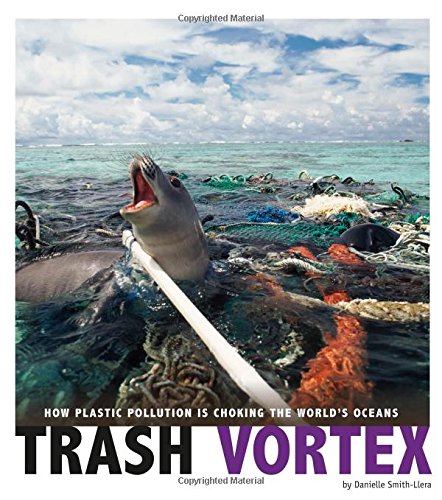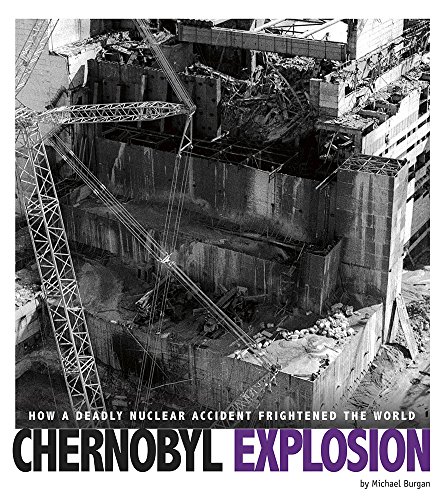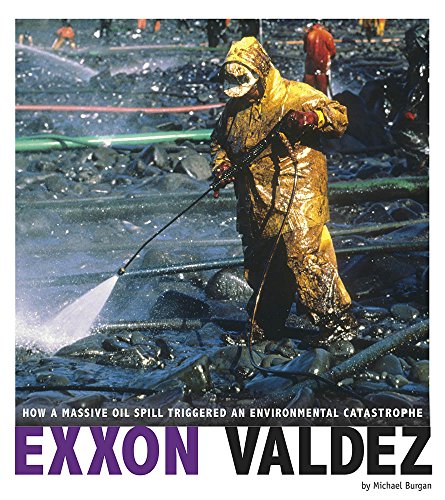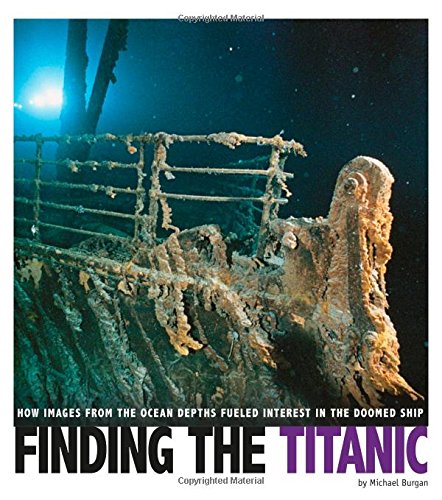-
Trash Vortex: How Plastic Pollution Is Choking the World's Oceans
Danielle Smith-Llera
Paperback (Compass Point Books, Jan. 1, 2018)Millions of tons of plastic slip into oceans every year. Some floats and travels slowly with the currents, endangering the health of marine animals. The rest is hardly visible but is far more dangerous. Tiny bits of plastic sprinkle the ocean's surface or mix into the sandy seafloor and beaches. It ends up inside birds, fish, and other animals, harming them-and ultimately humans. Experts struggle with fear and hope as they work to stop the flood of plastic threatening living organisms across the globe. Z
Z
-
Little Rock Girl 1957: How a Photograph Changed the Fight for Integration
Shelley Marie Tougas
Paperback (Compass Point Books, Aug. 1, 2011)Nine African American students made history when they defied a governor and integrated an Arkansas high school in 1957. It was the photo of a young girl trying to enter the school being taunted, harassed and threatened by an angry mob that grabbed the world's attention and kept its disapproving gaze on Little Rock, Arkansas. In defiance of a federal court order, Governor Orval Faubus called in the National Guard to prevent the students from entering all white Central High School. The plan had been for the students to meet and go to school as a group on September 4, 1957. But one student didn't hear of the plan and tried to enter the school alone. A chilling photo by newspaper photographer Will Counts captured the sneering expression of a girl in the mob and made history. Years later Counts snapped another photo, this one of the same two girls, now grownup, reconciling in front of Central High School. X
X
-
Olympic Gold 1936: How the Image of Jesse Owens Crushed Hitler's Evil Myth
Michael Burgan
Paperback (Compass Point Books, Jan. 1, 2017)Jesse Owens’ gold-medal winning feats at the 1936 Olympics in Berlin struck a mighty propaganda blow against Adolf Hitler. The Nazi leader had planned to use the German games as a showcase of supposed Aryan superiority. Instead there was American black athlete Owens on the podium being photographed by Hitler’s personal photographer, Heinrich Hoffmann. In addition, Owens would figure prominently in the groundbreaking film Olympia by Hitler’s favorite director Leni Riefenstahl. Photo and film captured Owens’ stunning success and revealed how wrong Hitler was in his beliefs. Z
Z
-
Lunch Counter Sit-Ins: How Photographs Helped Foster Peaceful Civil Rights Protests
Danielle Smith-Llera
Paperback (Compass Point Books, Aug. 1, 2018)On point historical photographs combined with strong narration bring the saga of the Woolworth lunch counter sit-ins in the early 1960s to life. Readers will learn about the four brave college students who started it all, as well as the many who came after. These events changed the world. The photographer who took the photographs shown in this book is now in his 90s, but he agreed to an exclusive interview for this book. Y
Y
-
Chernobyl Explosion: How a Deadly Nuclear Accident Frightened the World
Michael Burgan
Paperback (Compass Point Books, Jan. 1, 2018)The long-term damage from an accident at the Chernobyl nuclear power plant more than 30 years ago is still unknown. When explosions ripped through the reactor in rural Ukraine, then part of the Soviet Union, they spewed huge amounts of radioactive material into the atmosphere and caused the worst nuclear disaster in history. About 10,000 people have died or will die because of their exposure to radiation, and experts worry about the children born to parents who were living near the disaster area. With international help, Ukraine has enclosed the damaged reactor, giving scientists time to figure out what the future holds. Z
Z
-
Breaker Boys: How a Photograph Helped End Child Labor
Michael Burgan
Paperback (Compass Point Books, Aug. 1, 2011)Little boys, some as young as 6, spent their long days, not playing or studying, but sorting coal in dusty, loud, and dangerous conditions. Many of these breaker boys worked 10 hours a day, six days a week all for as little as 45 cents a day. Child labor was common in the United States in the 19th century. It took the compelling, heart breaking photographs of Lewis Hine and others to bring the harsh working conditions to light. Hine and his fellow Progressives wanted to end child labor. He knew photography would reveal the truth and teach and change the world. With his camera Hine showed people what life was like for immigrants, the poor, and the children working in mines, factories, and mills. In the words of an historian, the more than 7,000 photos Hine took of American children at work aroused public sentiment against child labor in a way that no printed page or public lecture could. Y
Y
-
Hubble Deep Field: How a Photo Revolutionized Our Understanding of the Universe
Don Nardo
Paperback (Compass Point Books, Aug. 1, 2017)A series of photos taken from space more than 20 years ago revealed thousands of unknown galaxies in a tiny patch of "empty" space. Called the Hubble Deep Field, the amazing image is made up of hundreds of photos combined into one. It was taken over the course of 10 days from the Hubble Space Telescope and has prompted astronomers and other scientists to speculate about universe's size, shape, and age. How long ago did the first galaxies appear? Have they always looked like they do today, or have their shapes evolved over time? And will they, along with the universe itself, go on expanding forever? The Hubble Deep Field has helped to answer some of these questions. Z
Z
-
Trash Vortex: How Plastic Pollution Is Choking the World's Oceans
Danielle Smith-Llera
Library Binding (Compass Point Books, Jan. 1, 2018)Millions of tons of plastic slip into oceans every year. Some floats and travels slowly with the currents, endangering the health of marine animals. The rest is hardly visible but is far more dangerous. Tiny bits of plastic sprinkle the ocean's surface or mix into the sandy seafloor and beaches. It ends up inside birds, fish, and other animals, harming them-and ultimately humans. Experts struggle with fear and hope as they work to stop the flood of plastic threatening living organisms across the globe. Z
Z
-
Birmingham 1963: How a Photograph Rallied Civil Rights Support
Shelley Marie Tougas, Kathleen Baxter, Alexa L. Sandmann Ed.D.
Library Binding (Compass Point Books, Dec. 1, 2010)In May 1963 news photographer Charles Moore was on hand to document the Children’s Crusade, a civil rights protest. But the photographs he took that day did more than document an event; they helped change history. His photograph of a trio of African-American teenagers being slammed against a building by a blast of water from a fire hose was especially powerful. The image of this brutal treatment turned Americans into witnesses at a time when hate and prejudice were on trial. It helped rally the civil rights movement and energized the public, making civil rights a national problem needing a national solution. And it paved the way for Congress to finally pass laws to give citizens equal rights regardless of the color of their skin. Y
Y
-
Man on the Moon: How a Photograph Made Anything Seem Possible
Pamela Jain Dell, Kathleen Baxter
Paperback (Compass Point Books, Feb. 1, 2011)It is a bizarrely beautiful image: A man in a spacesuit stands isolated in an alien world. His companion, the photographer, and their landing craft are reflected in his visor. This photograph, taken by Neil Armstrong of fellow astronaut Buzz Aldrin, is the most famous documentation of America’s 1969 moon landing. But to people in every country on Earth, it represented and still does so much more. The man in the photograph was hundreds of thousands of miles away from his home planet. He had conquered another world. It was, as Armstrong said, a giant leap for mankind. The photo of this historic event remains one of the most powerful and inspiring representations of the achievements of humankind. Y
Y
-
Exxon Valdez: How a Massive Oil Spill Triggered an Environmental Catastrophe
Michael Burgan
Paperback (Compass Point Books, Jan. 1, 2018)The biggest oil spill in U.S. history that polluted the pristine waters of Alaska decades ago and killed thousands of birds, mammals, and fish, still haunts the people who are living with its aftermath. On Good Friday 1989, the huge oil tanker, Exxon Valdez, ran aground in Prince William Sound, spilling millions of gallons of crude oil into the water-oil that would eventually cover more than 1,000 miles of shoreline. Cleanup began immediately but there is still oil in the sound and Alaskans say life will never be the same. Z
Z
-
Finding the Titanic: How Images from the Ocean Depths Fueled Interest in the Doomed Ship
Michael Burgan
Paperback (Compass Point Books, Aug. 1, 2017)On the night of April 14, 1912, as it made its first voyage, the luxury steamship Titanic struck an iceberg. Then, a few hours after midnight on April 15, the ship sank thousands of feet before settling on the ocean floor. And that's where it stayed, whereabouts unknown, for the next 73 years until it was discovered by oceanographer Robert Ballard and his crew. The pictures and video Ballard brought back from the 1985 discovery helped stir new interest in the Titanic's voyage and its resting spot. Y
Y